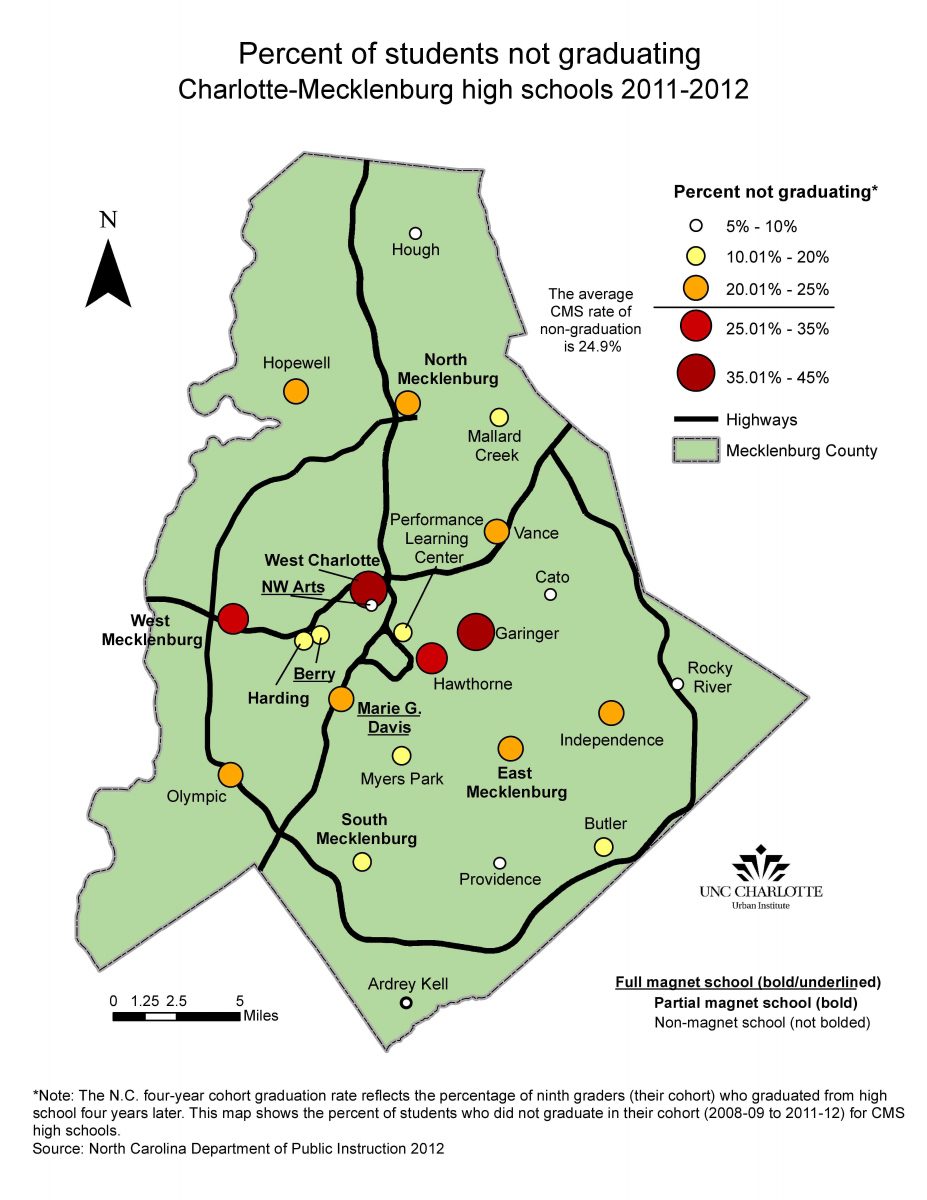High school graduation rates in CMS: A focus on the forgotten percentage

As a new school year begins, issues of student achievement and progress continue to dominate educational discourse. In Charlotte-Mecklenburg Schools, educators at all levels are charged with a goal of 100 percent student proficiency. That means every high school student must display mastery of complex academic skills and must graduate after four years of rigorous course work.
Leading this ambitious goal, the No Child Left Behind Act of 2001 and the newly created Race to the Top initiatives have mandated nationwide student achievement in reading/language arts and math by 2014. Charlotte Mecklenburg Schools’ Strategic Plan 2014 sets a district graduation rate goal of 90 percent. The newly funded Project L.I.F.T., a $55 million philanthropic initiative directed toward students in the West Charlotte corridor, also outlined a 90 percent student graduation rate for West Charlotte High School by 2017. Against this backdrop, the current CMS four-year cohort graduation rate has risen from 73.5 percent in 2011 to 75 percent in 2012.
When one compares CMS’ past and present graduation rates, positive statistical gain is evident and noteworthy. Yet while the number of graduating CMS seniors has increased, the number of students who can’t graduate on time or who drop out remains a concern. Though test scores and graduation rates have improved among many sub-groups, those achievements should not obscure the continuing plight of low-achieving students.
CMS’ newly improved graduation rates, though notable, summon the school system and our community to keep asking one pertinent question: What can be done for the forgotten 25 percent of the high school student population who did not receive a diploma? Within this group many African American, Latino, white, economically disadvantaged and special education students, as well as many with limited English proficiency, are not benefitting from our educational system. CMS must continue to work with educators and not only reach these students but make sure they graduate.
A closer look
To look more closely at the “forgotten percentage,” those students who did not graduate on time, we examined the distribution of those students across the school district. (see map below)
The map provides an overview of non-graduation rates across all CMS high schools for 2011-2012. It shows rates of non-graduation at different levels: 5 percent to 10 percent (Ardey Kell, Cato, Hough, Northwest School of the Arts, Providence and Rocky River); 10.01 percent to 20 percent (Phillip O. Berry, Butler, Harding, Mallard Creek, Myers Park, Performance Learning Center, South Mecklenburg); 20.01 percent to 24.9 percent (East Mecklenburg, Hopewell, Independence, Marie G. Davis, North Mecklenburg, Olympic and Vance); and 25.01 percent to 35 percent (Hawthorne and West Mecklenburg); and 35 percent to 45 percent (Garinger and West Charlotte). The CMS average is 24.9 percent non-graduation.
The information, a cause for genuine concern, indicates our greatest focus should be on reversing the trends at the four schools above the district average. It’s notable that the non-graduating students at those four schools make up nearly 40 percent of all the non-graduates in CMS for this year (36 percent of the non-graduates in the cohort covering 2008-09 to 2011-12).
At the same time, we must not lose sight of the fact that non-graduates are spread across the entire district. If CMS wants to reach its goal of 100 percent graduation rate and truly reach the goals of the No Child Left Behind and Race to the Top national initiatives, every high school and community has to work to get every student across that graduation stage. While percentages vary among high schools, we must keep in mind that those dry numbers are measuring real students’ lives that we have to change for the better.
Where do we go from here?
Today many CMS high schools are at a crossroads, undecided on which strategic plans are needed to help struggling students. Although financial resources are a key factor, schools also need community support to provide other resources such as:
- Additional intellectual capacity and resources from surrounding universities (including UNC Charlotte) to provide educators with solutions and successful strategies for teaching students from all ethnic, racial and socioeconomic backgrounds.
- Increased community and government agency involvement to work in partnership with CMS.
- Increased corporate and business involvement to provide state-of-the-art technological and innovative educational resources.
- Increased family involvement in the schooling experiences.
- A focused commitment by CMS on that “forgotten percentage” of non-graduating students across the entire district.
When all those factors are combined, we, as a community, will create an effective educational environment in which all students can learn.
In many ways, the 2012-2013 school year will be a major barometer of the impact of public education for years to come in Charlotte. We have a new superintendent. The Democratic National Convention will shine a spotlight on our city. Project L.I.F.T. is being implemented. This is our moment to show the nation – but more important, to show ourselves – that we can demonstrate how a community that pulls together can meet the educational needs of all students, regardless of their zip codes. Let’s roll up our sleeves, pull together and make a difference.
– Chance Lewis and Abiola Farinde
For an explanation on how the cohort graduation rate is calculated click here.
Notes on map data: Data is based on the N.C. released figures of the cohort graduation rate that show all high schools with greater than 95 percent graduation rate as 95+ percent. CMS has reported a 99 percent graduation rate for Cato and a 96.1 percent rate at Hough. The state reported a single graduation rate for Garinger of 63.1 percent. CMS showed five separate rates for the individual Garinger academies that ranged from 57 to 70.2 percent. A list of the cohort graduation rates released by CMS (sorted from highest to lowest with the change from the previous year) was compiled by the Charlotte Observer.
Abiola Farinde wrote this article while a graduate student working at the UNC Charlotte Urban Institute in 2011-2013.
Chance Lewis is the Carolyn Grotnes Belk Distinguished Professor of Urban Education. He can be reached by email at chance.lewis@charlotte.edu or by phone at (704) 659-6842.
Abiola Farinde, Chance Lewis
